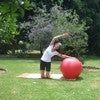Description
About This Video
Transcript
Read Full Transcript
Hello, I'm Rebecca Rotstein and today I'm going to do a tutorial on the risks with my friend Amy havens. We experienced this quite frequently that when we have people do weight bearing, or in other words, putting the weight on their wrist in a quadruped head position, that people will complain about discomfort in the risks, right? And especially in our buff bones program, we have a lot of people that will say, oh, I don't think I can do that. And I often say, well, what exactly is it that's leading to that discomfort? So I'm going to give you a quick little fix today that will enable many people to bear weight more easily than they might have, you know, five seconds prior. But I first want to explain to you the reason why I think this is so important.
Two aspects about the risk. One is the weight, the bearing of the weight through the risks is a way to stimulate the bones to strengthen them. And a little personal story for you is that I just had my bone density done again a couple of weeks ago for the first time in a little while, and my bone density in my wrist has risen really dramatically in the last couple of years. Yeah. And I'm am happy and be, I attribute that to my increased yoga practice because so much of yoga has an extensive amount of support and pressure going on through the risk chatter. Wrong goes downward dogs, planks, et Cetera. So I think that really has helped my wrist. I also though find that when I do more quadriped Ed work, I get much more experience and awareness through my trunk, not to strength through my shoulders, but connection into my trunk.
So I really don't believe that you should go weight bearing or quadro pet work because of discomfort, but we should find a way to modify it to enable people to do that. So let's talk about what some of the issues can be. There's plenty of ones that we could list off. I don't know where to begin, but one major or two major factors that I want to talk about are with the Fascia or the connective tissue. One has to do with the sleeve that runs around the entire forearm itself. So in anatomy we call this the form and up here is the arm and the other has to do with the interosseous membrane.
So the membrane that resides, I guess you could say between the radius and the Ulna. So if you look at the orientation of the form, it's really interesting with what we call the osteokinematics, the the bone interplay that notice how the radius moves around the Oana. So in anatomical stance you'd be like this, but then as soon as I asked you to bring your up in front of you and then rotate at the wrist, what happens is the radius rotates over around the Oma. And then I asked, ask you to go into extension on top of it. So there's no way that you can really truly bear weight in that position. If a, there is a problem of restriction between the two bones and also if you're not able to get that full rotation because of restriction that's going on through the Fascia here. So I call this the rug burn.
So if you had older siblings when you were growing up, you may be very familiar with this. I get to towards your Amy, relax your arm here for a moment. And let's, before I even do it, let's do a little before and after to show you the difference. So first go into a quadrupedal position here. So let's just notice the difference of where she is now. Do you feel any, any tension or restriction as you go forward?
You might not and that's okay. And now I want you to sit back as well and sit upright. In fact, ah, right where you are. Sorry, place your elbows by your sides and your palms forward and pretend that you're just resting here on a little shelf. Yeah, rest on me. Now pronate your wrist. So palms face down. And I don't know if everybody else can see this, but this one has a lot more ease in pronating than this one. She's not able to fully get the rotation in the wrist.
So what people will usually do as a result is compensate by rotating from the shoulder. And then I start getting problems through the shoulder. So if you, if you allow the shoulder to rest where it is and rotate from the forearm will have a much healthier joint situation. But what do we do about the restriction here? We do the following. You can actually stay right where you are. You do feel it right there. Great. So I'm going to give you a little rug burn. Just relax your arm. Totally. So I usually like people just to relax it right on me and I'm going to do it on her, but she can actually do it on herself by rotating inward and then out.
So I'm going to let you do that on yourself. So I'm just going to do a couple times in and then out. So you're going to move and rotate your wrist in the opposite direction that you're pulling it and then keep going up and up and up and back in all the way back down. Yeah, it feels icky, but it feels good. Then the second one, it's not necessarily going to target directly into that interosseous membrane, but I do believe or I do experience with clients that this is part of the restriction as well. So you're going to find the big meaty muscle here as you flex or actimmune as you extend. Yep. And you're just going to go laterally to that and you're going to pressurize and you're going to go down with the pointed tip of your finger hoping that your nails are not too tall, too long and pressurize down and you, what you can also do is move flexion and extension of the wrist alongside that, going down, down, down, and maybe make a fist and release.
And now try your quadrupedal gun and shift your weight forward and back and see how that feels. Because we don't want to, we don't want to push you into a position where you can't necessarily even have a passive extension and feels better. And then let's do our test once more where you sit back and you'll rest your arms on me here. Elbows by your sides. Because otherwise you're going to get essentially, um, a false reading and rotate in. Yes. And now there's so much more pronation that you have and returned back up.
So that's just a nice little trick and you can incorporate that into any of your classes so that when you're going into any kind of quadrupled work, you can allow people to have an easier ability to perform it. And we'll explore this a little bit in our mat class today. Thank you so much for joining.
Comments
You need to be a subscriber to post a comment.
Please Log In or Create an Account to start your free trial.


















